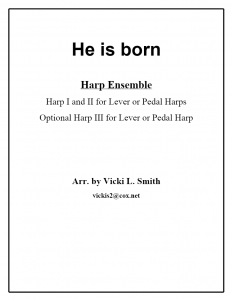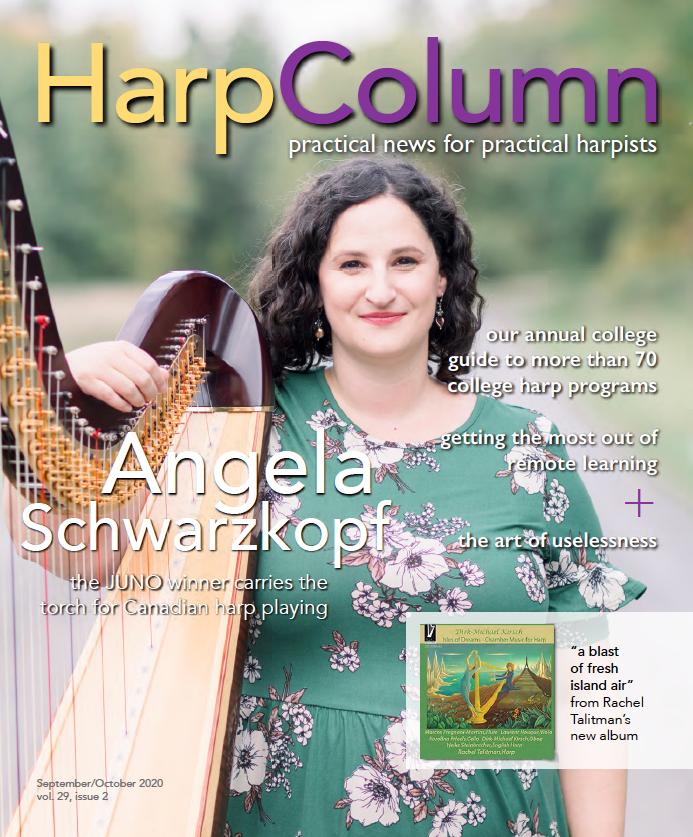
Although there is still quite a bit of uncertainty as to whether harpists will be playing live music for Advent and Christmas services this year, you may want to prepare some new music so you’ll be ready at a moment’s notice. Charles Peery has written Three Advent Pieces for Harp and Organ based on advent hymn tunes. Published by MorningStar Music Publishers, the suite includes “On Jordan’s Bank the Baptists Cry,” “Savior of the Nations, Come,” and “Rejoice, Rejoice, Believers.” They may be played as a suite (Peery suggests using them as prelude, offertory, and postlude), but they also stand alone very well.
The first piece is a lively tune in the key of C. The harp plays primarily in the upper registers in thirds, sixths, and octaves and doesn’t get lost or overpowered by the organ. The harp gets to play one long, rich glissando.
In “Savior of the Nations, Come” the harp begins alone with a long, rolled chord, followed by descending sextuplets in the first and second octaves. There are frequent meter changes and one key change from G minor to C minor. There is an ascending arpeggio on harp at the end followed by a final chord on organ.
The final selection in this trio is an energetic piece that begins in A major. The harp opens with grand octaves in both hands and some glisses. The two instruments harmonize with a flurry of eighth notes played on harp and a pulsing right hand on the organ against the melody in the left hand supported by pedal on organ. The harp takes the melody with variations on the second verse with both hands in unison while the organ provides backup on chords. The organ plays the melody for a few measures before the harp resumes and the music transitions to D major and a slower tempo. The instruments trade the melody back and forth before the harp brings back the octaves and glisses for a grand finish punctuated by chords on organ.
The set includes both a score (from which the organ plays) and a separate part for harp. The typesetting is easy to read, and the music is sightreadable for the intermediate to advanced harpist. No fingering is included, but the music falls logically within the hands. It is obvious Peery is familiar with both instruments, because he knows how to feature them both without overlooking either one. All pedal changes are notated in the middle of the staff where they are not likely to be missed.
Here’s hoping you’ll get an opportunity to play Peery’s arrangements this year.

In case you get a chance to play with multiple harps this Christmas season, Vicki L. Smith has arranged and self-published the French carol, “He Is Born” (a.k.a. “Il Est Ne”) for three pedal or lever harps. The third harp part is optional, so this also works as a duo. There are no lever or pedal changes.
The melody is carried primarily by harp one, with one short section handled by harp two. The second harp part includes tapping on the soundboard. There is just one verse, so it is very short and probably should be repeated. It is also very easy—even beginners could nearly sightread the parts. There is no fingering, so a novice may need some help there, but otherwise it is a good choice for beginners. The typesetting is easy to read, and the set comes with the full score and separate parts for harps one, two, and three.
Smith has also arranged some solos, including the lesser known “’Twas in the Moon of Wintertime,” a French-Canadian melody. The tune begins in G minor, and she establishes the melody with a single note in the right hand for the first verse.

The left hand accompaniment begins at measure 18 with sixteenth notes played in an arpeggiated pattern topped with the interval of a third. This is a little awkward, but since the right hand is still playing single notes, it’s possible to use the right hand to grab those thirds. She also incorporates some rolled chords and harmonics in the bridge before resuming the left hand pattern.
At the end of the second verse the key modulates to C minor. She includes the pedal marking below the staff and one diamond-shaped note for lever harp. A second necessary lever change was omitted for the third octave A and can easily be inserted.
At the end of this verse, she transitions back to G minor and the third octave A lever was again omitted. The final verse is the same as the second verse. A tag at the end repeats the single note melody in the right hand.
There is a fair amount of variety in this four-page arrangement, and it is an engaging melody. There is no fingering, but this is still sightreadable for the intermediate to advanced player. Smith has also done a nice harp duo version of this melody.
Most of the composer’s arrangements are available as downloadable PDFs (check with your favorite vendor), but the trio “He is Born” is currently available only in a print version. You may want to check out some of the other titles she has arranged for solo or ensemble. •






